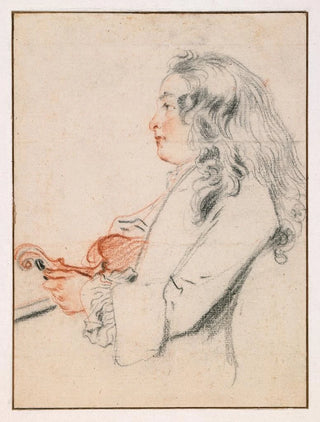Art print | A young gentleman tuning a violin - Jean-Antoine Watteau


View from behind

Frame (optional)
In the enchanting world of art, some works manage to capture the very essence of elegance and delicacy. "A Young Gentleman Tuning a Violin" by Jean-Antoine Watteau is a perfect example. This piece, a true ode to grace and beauty, evokes an atmosphere of lightness and melancholy, transporting the viewer into a universe where music and the art of living meet. Through this depiction, Watteau invites us to contemplate a fleeting moment, frozen in time, where passion for music blends with the beauty of human relationships. It is a work that, through its apparent simplicity, reveals a striking emotional depth, making each viewing experience unique and personal.
Style and uniqueness of the work
Watteau's work is distinguished by its rococo style, characterized by soft colors and delicate compositions. In "A Young Gentleman Tuning a Violin," the artist uses a subtle palette of pastel tones that evoke a dreamlike atmosphere. The central figure, carefully dressed, is immersed in a musical intimacy, while the fluid gestures and delicate expressions of the surrounding figures demonstrate an exceptional mastery of portrait art. Watteau manages to create a harmonious balance between the subject and the setting, each element contributing coherently to the whole. The details, whether in the draping of clothing or the nuances of light, add a tactile dimension to the piece, captivating the eye and inviting prolonged contemplation. This painting is not merely a depiction of a scene but a true tableau of feelings, where music becomes the universal language that unites souls.
The artist and his influence
Jean-Antoine Watteau, an emblematic figure of the 18th century, established himself as an essential master of French rococo. His innovative approach to genre painting and scenes of everyday life paved the way for many artists. Watteau captured moments of life with such finesse that he transformed the way painting was perceived in his time. His influence extends

Matte finish

View from behind

Frame (optional)
In the enchanting world of art, some works manage to capture the very essence of elegance and delicacy. "A Young Gentleman Tuning a Violin" by Jean-Antoine Watteau is a perfect example. This piece, a true ode to grace and beauty, evokes an atmosphere of lightness and melancholy, transporting the viewer into a universe where music and the art of living meet. Through this depiction, Watteau invites us to contemplate a fleeting moment, frozen in time, where passion for music blends with the beauty of human relationships. It is a work that, through its apparent simplicity, reveals a striking emotional depth, making each viewing experience unique and personal.
Style and uniqueness of the work
Watteau's work is distinguished by its rococo style, characterized by soft colors and delicate compositions. In "A Young Gentleman Tuning a Violin," the artist uses a subtle palette of pastel tones that evoke a dreamlike atmosphere. The central figure, carefully dressed, is immersed in a musical intimacy, while the fluid gestures and delicate expressions of the surrounding figures demonstrate an exceptional mastery of portrait art. Watteau manages to create a harmonious balance between the subject and the setting, each element contributing coherently to the whole. The details, whether in the draping of clothing or the nuances of light, add a tactile dimension to the piece, captivating the eye and inviting prolonged contemplation. This painting is not merely a depiction of a scene but a true tableau of feelings, where music becomes the universal language that unites souls.
The artist and his influence
Jean-Antoine Watteau, an emblematic figure of the 18th century, established himself as an essential master of French rococo. His innovative approach to genre painting and scenes of everyday life paved the way for many artists. Watteau captured moments of life with such finesse that he transformed the way painting was perceived in his time. His influence extends






